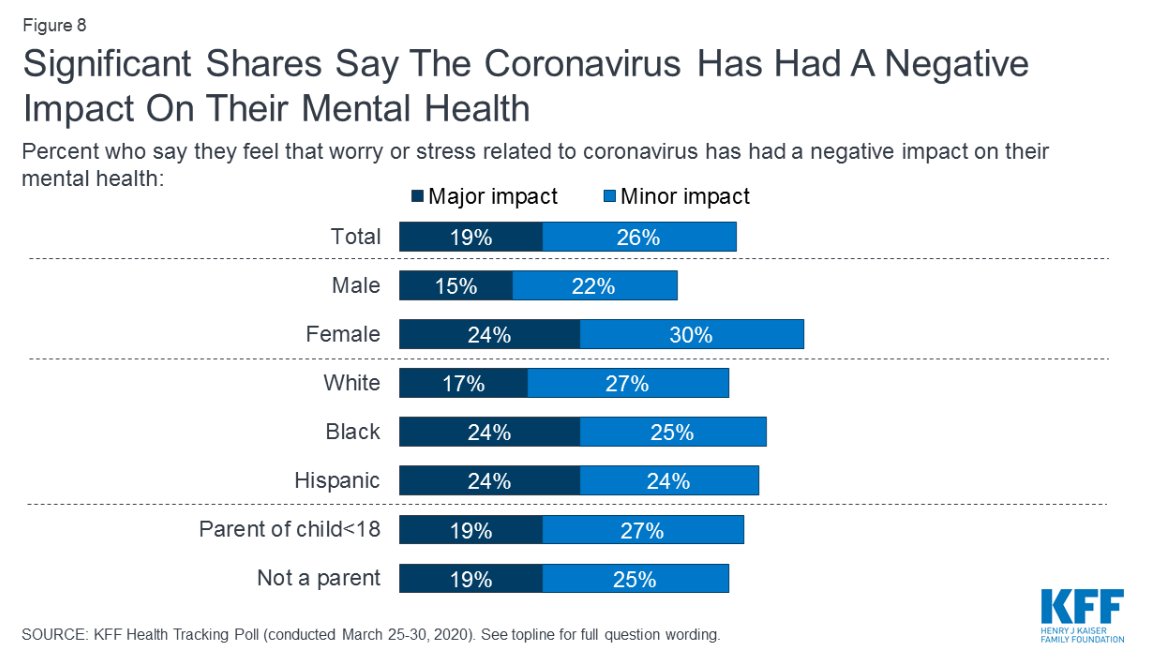What about gender and sexuality? There& #39;s been a lot of attention to fact that men are dying at higher rates from COVID-19 than women, and very little data on other gender identities or variation by sexuality. But what might we expect with mental health disparities? /1
The US Household Pulse Survey https://www.cdc.gov/nchs/covid19/pulse/mental-health.htm">https://www.cdc.gov/nchs/covi... indicates about 38 percent of women and 30 percent of men showing signs of clinical anxiety or depression, a sizable jump for both groups. But this gender gap is fairly typical in terms of mental health. /2
The Kaiser Family Foundation did find more women than men (54% compared to 37%) said the pandemic has negatively impacted their mental health https://www.kff.org/coronavirus-covid-19/report/kff-health-tracking-poll-early-april-2020/">https://www.kff.org/coronavir... /3
Even as men experience higher fatalities, women account for 55% of the increase in job losses in April ( https://www.npr.org/2020/05/09/853073274/women-bear-the-brunt-of-coronavirus-job-losses),">https://www.npr.org/2020/05/0... gender-based violence against women on the rise worldwide ( https://www.unfpa.org/sites/default/files/resource-pdf/COVID-19_impact_brief_for_UNFPA_24_April_2020_1.pdf),">https://www.unfpa.org/sites/def... and single moms especially stressed https://wxow.com/2020/05/28/single-moms-challenges-during-covid-19/">https://wxow.com/2020/05/2... /4
Ongoing research by @JessicaCalarco & @amy_knopf shows unique challenges women may feel in "managing" the pandemic within their households, with this likely straining their mental health https://twitter.com/procAnna/status/1266373452925005833
/5">https://twitter.com/procAnna/...
/5">https://twitter.com/procAnna/...
Pregnancy may be a particular mental health risk factor right now (w/ variation across groups). Recent article by @PoojaLakshmin raises concern of rise in maternal mental health conditions during the pandemic. This may be especially true for Black women https://www.nytimes.com/2020/05/27/parenting/coronavirus-postpartum-depression-anxiety.html">https://www.nytimes.com/2020/05/2... /6
I& #39;ve focused on cisgender people but what might we expect for transgender and gender nonbinary people& #39;s mental health? Depressive symptoms, suicidality, interpersonal trauma exposure, substance use disorders, & anxiety on average elevated in this group https://www.sciencedirect.com/science/article/abs/pii/S0272735817304208">https://www.sciencedirect.com/science/a... /7
A key concern is health care access. Many trans and nonbinary people face discrimination when seeking health care, and these barriers could make it harder to get treatment during the pandemic-- including mental health treatment. ( https://www.ncbi.nlm.nih.gov/pmc/articles/PMC6382457/">https://www.ncbi.nlm.nih.gov/pmc/artic... from Generations Study) /8
There are also concerns that distancing means transgender & nonbinary people may have trouble access their typical support networks or be stuck in violent home situations (see this news article on Latin America: https://www.thenewhumanitarian.org/feature/2020/05/19/coronavirus-trans-lgbti-latin-america-panama-colombia)">https://www.thenewhumanitarian.org/feature/2... /9
We know much less about mental health disparities by sexuality during COVID-19, with some preliminary evidence looking at LGBTQ people as a group and indicating reasons to expect a worse mental health impact. /10
One survey of 4000 US adults found LGBTQ adults more likely to have become unemployed, have
their work hours cut, feel that their personal finances are in worse shape, and be taking steps to actively prepare for the virus https://assets2.hrc.org/files/assets/resources/COVID_19_EconImpact-CommunitiesColor052020d.pdf?_ga=2.121153544.1007033875.1590173980-729347408.1584457030">https://assets2.hrc.org/files/ass... /11
their work hours cut, feel that their personal finances are in worse shape, and be taking steps to actively prepare for the virus https://assets2.hrc.org/files/assets/resources/COVID_19_EconImpact-CommunitiesColor052020d.pdf?_ga=2.121153544.1007033875.1590173980-729347408.1584457030">https://assets2.hrc.org/files/ass... /11
This is most pronounced for LGBTQ people of color-- for example, 22% of LGBTQ people of color became unemployed, compared to 14% of white
LGBTQ people and 13% of the general population showing why we need intersectional framework https://assets2.hrc.org/files/assets/resources/COVID_19_EconImpact-CommunitiesColor052020d.pdf?_ga=2.121153544.1007033875.1590173980-729347408.1584457030">https://assets2.hrc.org/files/ass... /12
LGBTQ people and 13% of the general population showing why we need intersectional framework https://assets2.hrc.org/files/assets/resources/COVID_19_EconImpact-CommunitiesColor052020d.pdf?_ga=2.121153544.1007033875.1590173980-729347408.1584457030">https://assets2.hrc.org/files/ass... /12
To hypothesize what this means for mental health, helpful to use minority stress framework. LGBTQ people experiencing heightened general stressors due to COVID-19 on top of minority stressors (e.g., health care discrimination) and this will likely harm their mental health /13
Meyer in describing minority stress model also points to important resilience factors w/in LGBTQ communities. Perhaps COVID-19 means a rise in solidarity and collective action, which could benefit mental health? Important to not just use deficit model https://www.apa.org/pubs/journals/features/sgd-sgd0000132.pdf">https://www.apa.org/pubs/jour... /15
That was a very quick overview of what we might expect with gender and sexuality with COVID-19. Please share your own insights and research on a population health perspective regarding gender and sexuality differences in mental health during this pandemic /16

 Read on Twitter
Read on Twitter



